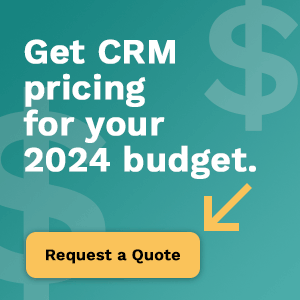
CRM: It's no longer a question of if, but a matter of when! In today's rapidly evolving digital landscape, the importance of Customer Relationship Management (CRM) cannot be overstated.
Customer experience continues to be the area worthy of focus and one that that yields returns. A customer relationship management system that is proven and effective can be a direct, positive impact on customer experience. If the question used to be, “Should I or when should I budget for CRM?” the current question is “How do I budget properly for CRM?” or even “How do I revise my strategic plan to reflect the large role CRM is now playing in day-to-day banking, then budget accordingly?”
If budgeting for CRM is not in your current plan, it needs to be! In Financial Brand’s “Banks and Credit Unions Rethinking Priorities Amid Economic Uncertainty,” Jim Marous explains, “. . . . financial institutions of all sizes [need] to improve operational resilience by rethinking back-office operations and investing in modern technology infrastructures that would ensure efficient delivery of services under a wide range of scenarios. Top priorities now include creating seamless digital experiences, personalizing customer interactions . . . and automating processes . . .” With that in mind, here are four tips for budgeting for CRM as you enter this year’s budgeting process.
Four Tips for Your Budgeting Pitch
1. Capitalize on the moment.
It’s the wrong time to overlook the importance of your upcoming technology expenditures. The importance of personalizing and automating tell you that a discerning technology investment begins with a robust CRM platform—that means having a tool that addresses several pressing issues:
- Personalizing every customer interaction
- Creating trust by offering the right products/services at the right time for each customer
- Automating email for communicating common and personalized information to all customers
2. Talk about both sides of the financial equation.
CRM, in its proper application, can reduce operating costs by increasing efficiencies, and it can increase revenue through its sales and marketing functions. You should talk about examples of both.
Operations Impacts
- CRM deployment often prompts a review of a financial institution’s internal process, highlighting areas ripe for gaining efficiencies.
- CRM prompts game-changer knowledge sharing between departments. For example, a CRM allows for an integrated, multichannel view of each customer and each lead, which encourages a productive and responsive relationship between sales teams and marketing teams and ties together back office support with the front line.
- CRM offers every team access to your customer information and complete interaction history. You can keep track of what’s already been offered or communicated and avoid duplicating efforts.
Revenue Impacts
- CRM gives you a better understanding of who your customers are and what they need. You can then target your interactions with them accordingly. This helps you to strategically up-sell, cross-sell, and nurture clients across all mediums.
- CRM offers robust marketing automation functionality; scaling personalized outreach to your customers puts campaigns into action and impacts the bottom line.
- CRM brings data together so that you can quickly know the value of customer accounts and household relationships and see customer ranking, trends, and month-to-date profitability. This allows salespeople to identify where the opportunities are and focus their efforts where it will have the most impact. The ability to segment customers according to profit equips you to better manage relationships and increase profits.

3. Talk to potential CRM partners before the budgeting moment-of-truth.
Costs vary significantly among providers depending on several factors (e.g., an asset-based pricing model which allows for deployment throughout the organization versus a per-seat pricing model which can limit usage.) Implementation times also vary. A 12-month implementation process affects the numbers differently than a 6-month process. Also, some CRM providers offer pricing plans when pitching their product, while others offer custom pricing tailored to your specific needs and current structure.
4. Already have a CRM? Negotiate an upgrade.
If your institution already has a CRM in place, it’s the perfect time to consider budgeting for improvements. Maybe the current product you are using is no longer the best fit for your organization. Some older products only update once or twice a month. Daily imports of data provide the most up-to-date picture of your customer putting you in the best position to serve. Investigate the latest CRM products available including the cost and ease of a transition. If you are happy with your current CRM, determine if there are modules (e.g., analytics, goals and incentives tracking, frontline pop-up messaging tool) you could add to increase the positive application of your system. Or, perhaps your provider offers customizations of your current CRM, which could increase efficiency and productivity.
With the right CRM in place, you’ll be equipped to manage these uncertain times at your institution as well as launch strategic sales, service, and marketing initiatives that benefit your business and attract the right customers. Don’t miss the current budgeting moment that will empower and position your team today and in the future.
Build Your Sales and Service Foundation with 360 View
CRM Platform offers robust capabilities that you can take advantage of as you create more data-driven, personalized customer experiences.We want to help you get started on the right foot during this budgeting season. Explore our Pricing Information and submit a personalized quote request. And download our exclusive white paper highlighting the invaluable benefits of CRM that you simply cannot ignore.


